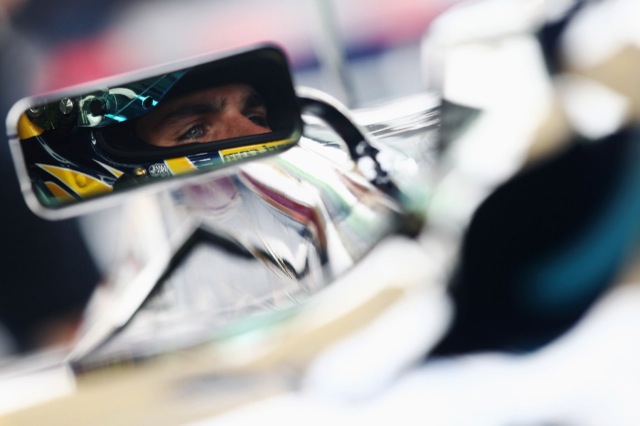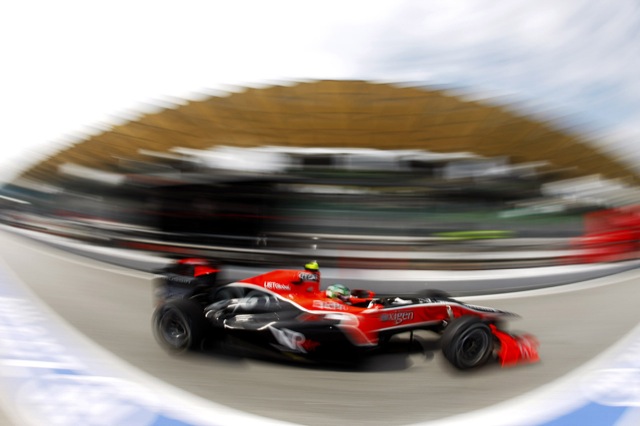The World Motor Sport Council met today in Monaco to discuss the future of Formula One and how best to reduce costs in order for all current teams to remain, and possibly in the future to entice further competition from new entries. So far, a raft of measures have been agreed upon and the team’s, voiced through their newly formed association FOTA, have unanimously agreed to the following changes to be implemented.
Engines
Engine life is to be doubled. Currently, an engine has to last two races, but under new instruction, the power units will have last four race weekends. This will be helped with a reduction of maximum revs from 19,000 to 18,000. Each team will be allowed four engines for testing, thus limiting the total number of power plants for each squad to just 20 per year. There can be no internal retuning of the engines, although trumpets and injectors are allowed to be adjusted. Renault’s engine will be allowed to be altered, a list of measures being agreed upon by all parties. It will not require any comparative testing.
Factories
From January 1st, 2009, any wind tunnels that exceed 60% scale are not to be used. This ban also extends to any wind tunnel that exceeds 50metres/second speeds. The team’s factories must also close for six weeks of every year.
Racing
The number of staff from each team allowed to attend a race has been reduced. This has been achieved by agreeing to share data on tyres and fuel, thus eliminating the need for spotters around the track. Bernie Ecclestone’s medal proposal will not be discussed further until market research has been competed and analysed. And finally, no in-season testing is allowed aside from the practice sessions during a race weekend.
These changes should, according to the WMSC, reduce the manufacturers budgets by as much as 30% compared with 2008. The private entries should see a greater reduction in costs.
For 2010, further proposals were agreed upon, and they are as follows:
Engines
By 2010, power plants should be made available to independent teams at a cost of less than €5million per team per season. The options are to use an independent supplier, like Cosworth, or use an already competing manufacturer. If an independent organisation is used, the deal has be agreed upon by December 20th, 2008. If a manufacturer is used, they will need to sign an guarantee of continuity contract, essentially meaning they cannot pack up shop one day and leave the sport high and dry.
Also, the same engine from 2010 will be used through 2011 and 2012 now, meaning there will not be a new power plant in 2011. The teams and the WMSC are discussing the use of a standardised transmission, but nothing has been agreed yet on this as further research is required.
Racing
The teams have agreed to ban tyre warmers, refuelling and mechanical purging of tyres. They have also agreed to using standardised radio and telemetry systems, although a supplier is yet to be discussed. And finally, they have agreed to discuss the possibility of reducing the race length, but are waiting to see the results of market research first.
There was also talk of further limitations being place on factory activities and aerodynamic research.
So what say you, readers of BlogF1? Are all these changes necessary, or does it not even go far enough? Is standardising some parts better, like the radios for example, but engines and transmissions less so? Or is it all necessary to help the sport continue into the future? Have your say in the comments below…






















IMHO, 2009 will be a year to forget, just like 2005. Most of these new rules are retarded and useless.
What exactly is mechanical purging of tyres supposed to mean?
Wind tunnels that exceed 60% scale are NOT to be used. I know, picky, picky. I, too, would like to know what mechanical purging of tyres is.
Why not just give everyone the same car and paint it different colours?!
This is meant to be the pinnacle of motorsport, not some cheap everyone can enter, weekend event.
Indy Lites?
Thanks donwatters, typo amended. 🙂
Tyre purging has something to do with inflation, I think. Will look for a proper definition after I’ve eaten some food.
Tyre purging is the riddance of air from the tyre so nitrogen can be used to inflate the tyre. Nitrogen is more stable, hence why Formula One uses it instead of air. It isn’t necessary to purge the tyre though, as nitrogen can be used with air still in the tyre.
I have a distinct uneasiness about this ruleset, even though I haven’t studied it very carefully. Why? I’ve already spotted a problem with the engine rulings.
Engine life will be doubled. It was supposed to be two races this year. So next year it will be four races per engine.
Each driver may have four engines. Four engines x four races per engine = 16 engines.
Check the calender. Number of races? 17.
In other words, anyone designing an engine to the regulations will find that they get a ten-place grid penalty in Abu Dhabi, simply because the normal life of the engine specified will be insufficient for the calender. Oops.
The system messed up my post when I attempted to put in a hyperlink to the 2009 F1 calender. Here is a re-post minus the hyperlink:
I have a distinct uneasiness about this ruleset, even though I haven’t studied it very carefully. Why? I’ve already spotted a problem with the engine rulings.
Engine life will be doubled. It was supposed to be two races this year. So next year it will be four races per engine.
Each driver may have four engines. Four engines x four races per engine = 16 engines.
Check the calender. Number of races? 17.
In other words, anyone designing an engine to the regulations will find that they get a ten-place grid penalty in Abu Dhabi, simply because the normal life of the engine specified will be insufficient for the calender. Oops.
Alia, can you just copy+paste the link into the comment box and hit Submit? It should just display the address and auto link it to the location…
If not, no stress. When the calendar is finally confirmed, which I believe should have been today, I’ll fix BlogF1’s calendar page. The reason mine is out of date is because I got fed up of changing it every other day when the dates and races were in such flux.
Air contains water (moiture) which affects how it expands and contracts in relation to temperature and pressure. Nitrogen can be dried to a higher degree so is more predictable. Teams will still purge tyres but instead of using an automated pump system they will do it manually like they did before the pumps were used.
I assume the 60% wind tunnel rule refers to the scale of the models and not the tunnels. THat would mean teams who have a tunnel that is more than 60% scale would have to build a new tunnel and that has to be undesireable in the current climate.
Maybe Bernie is axing another track off the calendar!?
Yes Steven, 60% scale models, but presumably that means the size of the wind tunnel is also about 60% of the regular size used to run a 100% scale car. I mean, it can’t be very environmentally friendly to have a huge powerful wind tunnel just to try out a tiny 60% model in comparison.
My language is a bit poor at the moment – I blame the time of year! 🙂
I get the point you are making Ollie but if a team has a 100% tunnel they are not going to scrap it and build a new one. This looks like a measure that is aimed at new teams coming into the sport and at saving the teams who currently have smaller tunnels the cost of a better one. I don’t know if there is a limit on the number of tunnels a team can use because earlier this year Honda admitted to running 4. I have no idea what they were doing with them because there is no obvious result.
Totally, I wasn’t refuting that at all. In fact, I typed (but deleted because it didn’t really work properly) that “what the hell are teams with huge wind tunnels going to do now? I know, spend more money, just like you said Steven.”
I really don’t like these rules. Does F1 have any kind of track record at successfully cutting costs? Couldn’t they have saved $100M or so by restricting the airflow and revs of the V10’s? Shouldn’t there be some in-season testing if there is to be any true development on the cars during the season? How lame will it be if we all know exactly who has the season’s best car at Melbourne? I don’t get F1 anymore; as an American I have several race series that have so many entrants, they actually have to restrict the field! Now I’m not trying to debate the relative excitement of race series as a whole (NASCAR and their circle tracks bore me), but having 43+ cars racing for 33 spots on the grid is pretty exciting. 33 cars on track is exciting- there is passing and contact and racing! something F1 has steadily mandated out over the past 15 years. To respond to Andre:
“This is meant to be the pinnacle of motorsport, not some cheap everyone can enter, weekend event.”
If F1 cut the pricetag down to $100-150M/season it would still be the most expensive racing series in the world, but at that price, there would be interest from independents around the world.
Finally, just a wild thought, but what if F1 went pack to production drivetrains? Say manufacturers could use any engine they made more than 500-1000 copies in road legal vehicles that they actually sold to the general public? What road-going engine and transmission couldn’t last 4 races? I’m sure there is a set of allowed modifications to help extend the endurance of the engine the manufacturers could up with. And what manufacturer would lose money on such a package at $10M/season to other teams? If anything, it probably wouldn’t cost that much and I for one would love to see the return to each team able to use different engine configurations. Bring back the V12 to F1!
I’m in two minds, some of the rules seem like quite good cost cutting ideas and some seem like they might dampen the F1 racing experience. For example, the extending of an engine life to 4 races is good as it will save costs and I think could help improve reliability of very high performance engines, something which could transfer into road cars (supercars?).
The banning of refueling I think would be a massive shame as then that element of strategy over the race would be lost entirely, over the years there have been a few races which have started out fairly dull or processional only to be turned on their head by a refueling strategy or weather plus refueling strategy injects a sudden burst of excitement into a race. Also if the race was to stay the same length then the design implications of banning refueling would be pretty substantial as well.
Admirable effort WMSC and FOTA but there are definitely issues there which could change the F1 experience in a bad way.
“What road-going engine and transmission couldn’t last 4 races?”
None. No roadgoing anything would last one race in F1.
Huh? Does anyone think races are too long right now? F1 is one of the few sports that I know of that actually runs under 2 hours from start to finish.
@Steven Roy-
Explain to me why there are no road going engines that couldn’t be race-prepared to last ~800 miles. Seriously? Production blocks are so flimsy that they couldn’t last 4 races?
I’m going to disagree with your opinion and say that almost any current high performance engine could be made to push a 550kg car around a track at high revs for 800 miles with a very reasonable (ie inexpensive) course of modifications.
Just my tuppence about wind tunnels… and F1…
They can’t penalize teams with tunnels capable of 100% size.. that would be such a waste! – I know the renult wind tunnel is capable of 100% size with rolling road! – But they also can increase the pressur to 2 BAR (double atomuspheric pressure) to give realistic flow on 50% scale models – I assume this will still be alowed?
Incedently one of the most expencive parts of the wind tunnel was making it 100% proof when under pressuer – apparently if a weld goes when under pressure it would be the equivilant energy release as 100kg of TNT!!! – Think of the huge volume of pressureized air in that massive tunnel! – So does making tunnels restricted to 60% realy make it cheeper for the smaller teams?
Why o Why don’t they just say you have 6ft x 10ft x 6ft and run on normal fuel… now build me a monster! – I would allow driver crash safty rules and MAYBE to stop death, a limmit to the HP to say 1000HP? – ‘O’ and one last rule – 1 car, 1 engine, 1 season!